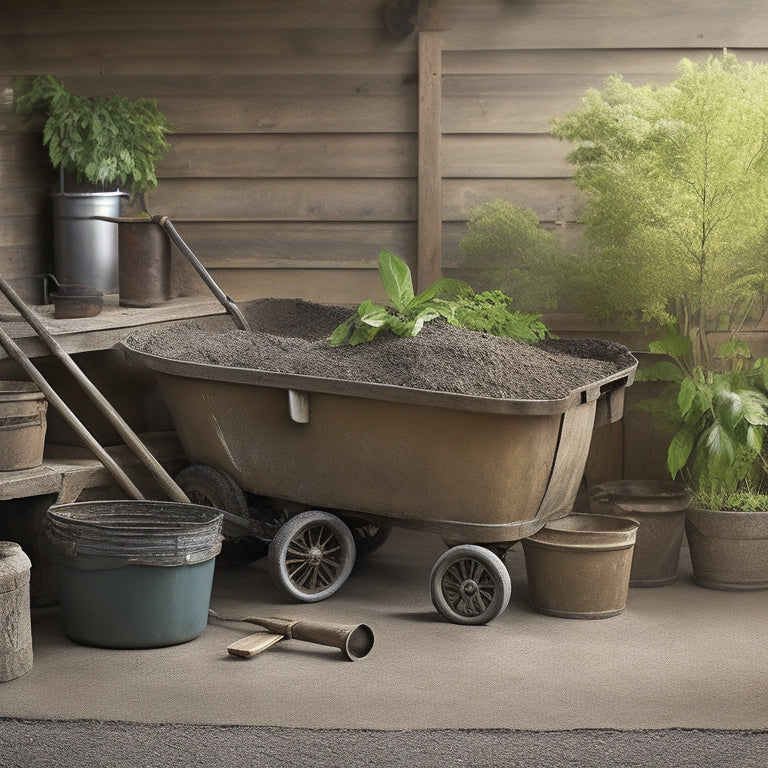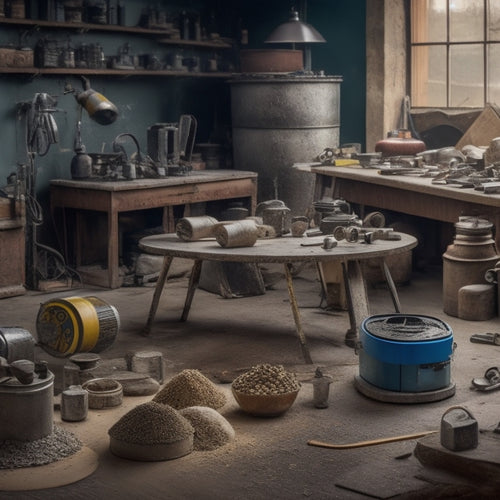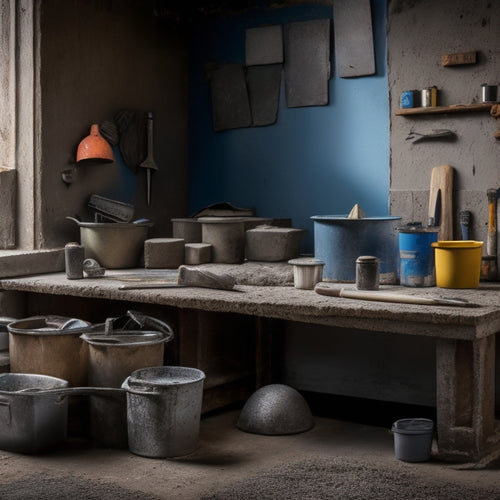
Buckets and Tools for Mixing Concrete Like a Pro
Share
When mixing concrete like a pro, you'll need sturdy, heavy-duty buckets, essential mixing tools, and measuring cups. A 5-gallon bucket is versatile and should be 2-3 times the volume of concrete being mixed. Look for buckets with measuring marks, sturdy handles, and non-slip bottoms. Mixing tools include mixing sticks, paddles, and power drills, while measuring tools like cups or scales guarantee accurate ratios. Don't forget safety gear like gloves, safety glasses, and dust masks. With the right buckets and tools, you'll be well on your way to efficient and effective concrete mixing - and there's more to explore to take your skills to the next level.
Key Takeaways
• Use sturdy, heavy-duty 5-gallon buckets with measuring marks, sturdy handles, and non-slip bottoms for mixing concrete.
• Essential mixing tools include mixing sticks, paddles, and power drills, with different paddle types available for specific tasks.
• Wear protective equipment such as gloves, safety glasses, and dust masks to reduce the risk of accidents during concrete work.
• Maintain accurate mixing ratios, avoid overmixing or undermixing, and use a mixing stick or paddle for combining the concrete mix.
• Organize tools and materials effectively by designating buckets for specific tool categories to streamline workflow and enhance safety.
Essential Items in a Bucket
You'll need a sturdy bucket with a few essential items to get started with mixing concrete, including a mixing stick, gloves, safety glasses, and a dust mask. The type of bucket you choose matters - a heavy-duty, 5-gallon bucket with a sturdy handle is ideal. Avoid using buckets with cracks or weak spots, as they can break under the weight of the concrete.
When it comes to mixing ratios, it's vital to get them right. A standard mix ratio is 1 part cement to 2 parts sand to 3 parts gravel. However, this may vary depending on the specific type of concrete you're working with and the project's requirements. Make sure to consult the instructions on the cement bag or talk to a professional if you're unsure.
With the right bucket and mixing ratio, you'll be well on your way to mixing concrete like a pro. Remember, safety should always be your top priority, so don't skip those essential items - they're there to protect you from the hazards of mixing concrete.
Checklist for Concrete Mixing Buckets
With your mixing ratio and safety gear in check, it's time to confirm your bucket is fully stocked with the right tools for the job. You don't want to be mid-mix and realize you're missing a vital item.
Start by checking the quality of your bucket materials - a sturdy, heavy-duty bucket is essential for withstanding the rigors of concrete mixing. Next, verify you have a reliable mixing stick or trowel, as well as a measuring cup or scale to accurately measure your mixing ratios.
Don't forget to include a dust mask, gloves, and safety glasses in your bucket to protect yourself from the mixing process. A bucket liner or drop cloth can also be useful for easy cleanup and preventing damage to your workspace.
Finally, consider adding a bucket dolly or wheels to make transporting your heavy bucket a breeze. By following this checklist, you'll be well-prepared to tackle any concrete mixing project that comes your way.
Mixing Concrete Without the Mess
When you're mixing concrete, it's crucial to contain the mess to avoid a huge cleanup job later.
You can do this by designating a specific area for mixing and taking steps to prevent spillage.
Minimize the Mess Area
Minimize the Mess Area
Cover your work area with a drop cloth or plastic sheeting to contain the mess and make cleanup easier. This simple step will save you time and frustration in the long run. By containing the mess, you'll prevent concrete from seeping into cracks and crevices, making it easier to clean up and reducing the risk of damage to your tools and surrounding surfaces.
Spill Prevention Strategies
| Strategy | Benefits |
|---|---|
| Lay down a drop cloth | Protects surfaces from stains and damage |
| Use a mixing tray | Contains spills and makes cleanup easy |
| Keep a clean workspace | Reduces risk of accidents and injuries |
| Use a scoop or trowel | Prevents spills and messes when transferring concrete |
| Clean tools immediately | Prevents concrete from hardening on tools |
Efficient Mixing Techniques
What's the most effective way to mix concrete without creating a mess? It starts with mastering efficient mixing techniques. By following a few simple tips, you'll be well on your way to producing high-quality concrete with minimal cleanup.
Here are three essential strategies to keep in mind:
-
Get your mixing ratios right: Make sure you're using the correct proportions of cement, sand, and water to avoid a too-wet or too-dry mix. This won't only affect the strength of your concrete but also reduce the likelihood of mess and waste.
-
Use timing techniques to your advantage: Mix your concrete in stages, allowing each batch to rest for a few minutes before adding more ingredients. This helps prevent over-mixing, which can lead to a sloppy, hard-to-work-with consistency.
-
Work methodically and deliberately: Take your time when mixing, and avoid rushing the process. This will help you maintain control over the concrete and prevent accidents.
Most Important Concrete Mixing Tools
When it comes to mixing concrete, you'll need the right tools to get the job done efficiently and effectively.
You're about to learn about the most essential tools that'll make all the difference in your concrete mixing project.
From mixing bucket essentials to concrete mixing paddles and power mixing drills, you'll discover the must-haves to guarantee a successful outcome.
Mixing Bucket Essentials
You'll need a sturdy mixing bucket with a capacity of at least 2-3 times the volume of the concrete you're mixing to assure efficient and safe mixing. This guarantees you can combine all the ingredients properly without overflowing the bucket. A larger bucket capacity also allows for better control over mixing ratios, which is critical for achieving the right consistency and strength of the concrete.
Here are some essential features to look for in a mixing bucket:
-
Rugged construction: A heavy-duty bucket that can withstand the rigors of mixing concrete without cracking or breaking.
-
Non-slip handle: A comfortable, secure grip that makes it easy to lift, carry, and pour the mixed concrete.
-
Measuring marks: Gradations or markings on the side of the bucket to help you measure ingredients accurately and maintain the correct mixing ratios.
Concrete Mixing Paddles
With your mixing bucket ready, you're now prepared to tackle the most physically demanding part of the mixing process: combining the ingredients. That's where a sturdy concrete mixing paddle comes in. This essential tool helps you mix concrete efficiently and safely, reducing the risk of injury from overexertion.
When choosing a concrete mixing paddle, consider the type of project you're working on and the mixing speed you need. There are three main paddle types: square-edged, rounded-edged, and trowel-style. Square-edged paddles are best for heavy mixing, while rounded-edged paddles are ideal for smaller batches. Trowel-style paddles are perfect for finishing work.
A good paddle should have a comfortable grip and a durable, rust-resistant blade. Remember to always maintain a safe mixing speed to avoid splashing and spattering concrete.
Power Mixing Drills
If you're serious about mixing large batches of concrete efficiently, a power mixing drill is an essential tool to have in your arsenal. It's a game-changer for large-scale projects, allowing you to mix massive quantities of concrete quickly and easily. But, it's vital to use it safely and effectively.
Here are some key things to keep in mind when working with a power mixing drill:
-
Choose the right drill speed settings: Start with a low speed to break up the concrete, then gradually increase the speed to achieve the desired consistency.
-
Maintain power drill safety: Always wear gloves, safety glasses, and a dust mask to protect yourself from flying debris and concrete dust.
-
Use the correct mixing paddle: Select a paddle designed for heavy-duty mixing to guarantee efficient and effective concrete mixing.
Buckets and Accessories You Need
Having the right buckets and accessories on hand saves you time and frustration when mixing concrete.
You'll need a bucket that's sturdy, reliable, and suitable for the job. Bucket materials matter – steel buckets are durable and resistant to rust, while plastic buckets are lightweight and easy to clean. Consider the size of your bucket, too. A 5-gallon bucket is a good all-purpose choice, but you may need a larger or smaller one depending on the size of your project. Make certain your bucket has a sturdy handle and a non-slip bottom to prevent accidents.
You'll also need some essential accessories. A bucket scoop or trowel is a must-have for measuring and mixing ingredients. A mixing stick or paddle is necessary for combining the concrete mix.
Don't forget gloves, safety goggles, and a dust mask to protect yourself from the mixing process. Having these basics on hand will guarantee you're prepared to mix concrete like a pro.
With the right buckets and accessories, you'll be able to mix and pour concrete efficiently and safely.
Mixing and Finishing Essentials
You'll need a range of mixing and finishing tools to transform the concrete mix into a smooth, even surface that's ready for its intended use. These tools will help you achieve the perfect mixing ratios and finishing techniques that guarantee a strong and durable concrete structure.
Here are some essential tools you'll need:
- A trowel for spreading and smoothing the concrete
- A float for removing excess water and achieving a smooth finish
- An edger for creating clean edges and joints
When working with concrete, it's vital to prioritize safety. Wear protective gear, including gloves, safety glasses, and a dust mask, to prevent injuries and exposure to hazardous materials.
Always follow the manufacturer's instructions for mixing and applying concrete, and take necessary precautions to avoid overmixing or undermixing, which can compromise the structural integrity of your project.
Pro Tips for Bucket Organization
Pro Tips for Bucket Organization
Organize your mixing and finishing tools in designated buckets to streamline your workflow and reduce downtime spent searching for misplaced equipment. This simple yet effective strategy will save you time and frustration on the job site. To take your bucket organization to the next level, follow these pro tips:
| Bucket Label | Tool Category | Bucket Storage |
|---|---|---|
| Mixing Tools | Trowels, mixing sticks, and scoops | Store near mixing area for easy access |
| Finishing Tools | Floats, edgers, and finishing trowels | Store near finishing area to reduce travel time |
| Safety Equipment | Hard hats, safety glasses, and gloves | Store in a designated safety bucket near the entrance |
| Cleaning Supplies | Brooms, dustpans, and cleaning solutions | Store in a designated cleaning bucket near the exit |
Frequently Asked Questions
Can I Mix Concrete in a Rusty Bucket?
You're wondering if you can mix concrete in a rusty bucket? Think again!
A rusty bucket compromises safety and concrete mixing efficiency. Rust can contaminate the concrete, affecting its strength and durability.
Plus, rusty metal can react with the alkaline properties of concrete, causing it to set too quickly or unevenly.
Play it safe and use a clean, rust-free bucket to guarantee a successful mix.
How Do I Clean Dried Concrete From Tools?
You'll need some effective cleaning techniques to remove dried concrete from your tools.
Start by scraping off excess concrete with a stiff brush or putty knife.
Then, soak the tools in warm water and mix in a concrete removal product or white vinegar.
Let it sit for a few hours before scrubbing with a wire brush.
Rinse thoroughly and dry to prevent rust.
Remember to wear gloves and safety goggles to protect yourself from harsh chemicals and flying debris.
Are All Concrete Mixing Buckets Food-Grade?
When it comes to concrete mixing buckets, you're right to wonder if they're food-grade. The answer is, it depends on the bucket materials.
Not all concrete mixing buckets meet food-grade standards, which is a concern if you plan to use them for other projects.
Look for buckets made from high-density polyethylene (HDPE) or polypropylene (PP), which are generally food-grade.
Always check the manufacturer's specifications to verify the bucket you choose is safe for your needs.
What Is the Ideal Temperature for Mixing Concrete?
Mixing concrete is like baking a cake - the ingredients must come together in perfect harmony.
When it comes to temperature, you're aiming for the sweet spot. Ideally, you want it between 50°F and 70°F (10°C and 21°C) for ideal concrete curing.
Temperature effects can be drastic, so avoid mixing in extreme heat or cold.
You're not just building something, you're creating something that'll last - so get it right from the start.
Can I Use a Drill to Mix Small Batches of Concrete?
When mixing small batches of concrete, you can use a drill, but it's essential to choose the right type. A heavy-duty drill with a mixing paddle or a dedicated concrete mixer drill is ideal.
Avoid using a regular drill, as it may not handle the thick mixture. Employ a slow and steady mixing technique to avoid splashing and guarantee a consistent mix.
Always wear protective gear, including gloves and safety glasses, to prevent injury.
Conclusion
You've got the know-how to mix concrete like a pro! With the right buckets and tools, you're ready to tackle any project.
Did you know that the average American uses about 600 pounds of concrete per year? That's a lot of mixing!
Now, imagine having a tidy workspace, efficient mixing, and a flawless finish. It's a reality with the right gear and a few pro tips.
Get mixing and make your concrete projects a success!
Related Posts
-

Essential Tools for Painting Concrete Walls
When painting concrete walls, you'll need a range of specialized tools to achieve a professional-looking finish. Star...
-

Top DIY Concrete Grinding and Polishing Tools
When selecting DIY concrete grinding and polishing tools, you'll want to take into account a range of factors to guar...
-

Top Tools for Beginners in Concrete Masonry Coating
You're about to begin a concrete masonry coating project, and having the right tools is essential. Start with essenti...


